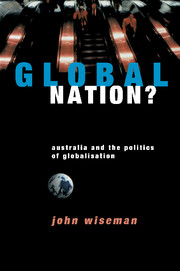Book contents
- Frontmatter
- Contents
- Abbreviations
- Acknowledgments
- 1 Introduction: Australia and the Politics of Globalisation
- 2 Breaking the Spell? Understanding Globalisation
- 3 Transforming the Global Economy? Trade, Capital and Power in the Late Twentieth Century
- 4 Onto the Global Racetrack? Globalising the Australian Economy
- 5 The Price of Competitiveness? The Social Impact of Globalisation on Australia
- 6 Wired to the World? Australia and the Globalisation of Media and Information Technologies
- 7 Nowhere to Hide? Australia in the Global Environment
- 8 Where in the World? Transforming Australian Political Relationships and National Identities
- 9 Alternative Strategies? Thinking and Acting Globally and Regionally
- 10 Alternative Directions? Thinking and Acting Locally and Nationally
- 11 Conclusion
- Notes
- Bibliography
- Index
1 - Introduction: Australia and the Politics of Globalisation
Published online by Cambridge University Press: 20 May 2010
- Frontmatter
- Contents
- Abbreviations
- Acknowledgments
- 1 Introduction: Australia and the Politics of Globalisation
- 2 Breaking the Spell? Understanding Globalisation
- 3 Transforming the Global Economy? Trade, Capital and Power in the Late Twentieth Century
- 4 Onto the Global Racetrack? Globalising the Australian Economy
- 5 The Price of Competitiveness? The Social Impact of Globalisation on Australia
- 6 Wired to the World? Australia and the Globalisation of Media and Information Technologies
- 7 Nowhere to Hide? Australia in the Global Environment
- 8 Where in the World? Transforming Australian Political Relationships and National Identities
- 9 Alternative Strategies? Thinking and Acting Globally and Regionally
- 10 Alternative Directions? Thinking and Acting Locally and Nationally
- 11 Conclusion
- Notes
- Bibliography
- Index
Summary
An Aboriginal girl in Alice Springs cradles her Pocahontas Barbie while she watches the Winter Olympics on satellite TV. Another factory closes in Newcastle because it can no longer compete with Chinese wages. Another Latrobe Valley power station is sold off to a United States energy corporation. Moody's credit-rating agency warns that Australian governments must keep cutting taxes and services – or else. Australian environmentalists and Aboriginal groups mobilise support from the European Parliament in their opposition to the opening of the Jabiluka uranium mine in the Northern Territory. A public park in Melbourne is taken over for an international carrace beamed around the world. A Tasmanian mother frets about her sunburned child and the risk of skin cancer. This is Australia in an age of globalisation.
Globalisation is the most slippery, dangerous and important buzzword of the late twentieth century. It is slippery because it can have many meanings and be used in many ways. It is dangerous because too often it is used as a powerful and simplistic justification for the endless expansion of unregulated capitalist relations into every part of life in every corner of the globe. It is important because debates about globalisation can illuminate a world in which time and space have been so dramatically compressed that distant actions in one corner of the globe have rapid and significant repercussions on people and places far away.
- Type
- Chapter
- Information
- Global Nation?Australia and the Politics of Globalisation, pp. 1 - 10Publisher: Cambridge University PressPrint publication year: 1998



